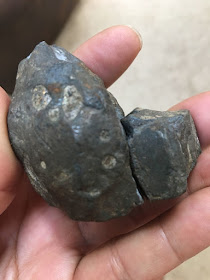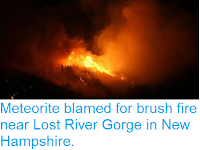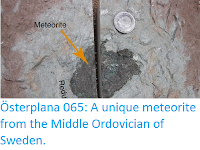A meteorite apparently hit a house in the town of Pawleys Island in Georgetown County, South Carolina, on 26 September 2017. The object was initially spotted by resident Melanie Casselman, who noticed a strange rock in her yard, but paid it no further attention, assuming it had been thrown there by local kids. However later that day her partner, Dennis Suszko, found a second piece of similar rock, which his son, Christopher, was able to fit to the original rock, as well as minor damage to their roof, consistent with having been hit by a falling rock. Noticing that the rocks did not resemble any others to be seen locally, Casselman and Suszko searched online and found images of similar looking meteorites. This prompted them to contact astrophysicist Sean Brittain of the Department of Physics & Astronomy at Clemson University, who confirmed the object was in fact a meteorite.
The September 2017 Pawleys Island Meteorite. Clemson University.
Brittain was able to confirm the iron-rich rock was a meteorite by the presence of flowlines on its surface, indicating that that surface had been molten as it fell through the atmosphere. Meteorites that fall to the ground are typically chunks of larger rocks that have exploded in the upper atmosphere due to heat from friction caused by the velocity from their orbit which far exceeds that caused by gravitational falling. Meteorites that fall to Earth are a byproduct of such explosions,
fragments of rock from the interior of the asteroid that fall to Earth
under gravity, which is not enough to heat them. Such meteorites
typically have fire-blackened, melted, exteriors, a result of the initial heating
and explosion, but this initial heat is usually lost through convection
into the interior of the meteorite (which, having come from space, is
typically only a few degrees above absolute zero when it begins its
journey through the atmosphere), so that the object is cold (usually
very cold) when it reaches the ground.
See also...
Follow Sciency Thoughts on Facebook.







